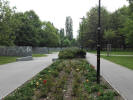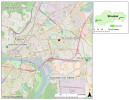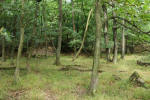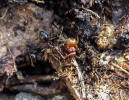







Volume 22, year 2017
Choreutis nemorana (Hübner, 1799) and Gracillaria loriolella (Frey, 1881) – two Lepidoptera species new to the fauna of Slovakia
Andrej Lendel
Folia faunistica Slovaca 22: 1–5
Abstract: Two species, Choreutis nemorana (Hübner, 1799) and Gracillaria loriolella (Frey, 1881), are added to the Slovak fauna of Lepidoptera. The species have been found in the westernmost part of Slovakia in Centnúz (Malacky env.), later in another places in the country. The moths, larva, pupa and exuvia of Choreutis nemorana are illustrated.
Key words: Lepidoptera, Choreutidae, Gracillariidae, Choreutis nemorana, Gracillaria loriolella, faunistic records, Slovakia








Received 17 January 2017 ~ Accepted 20 January 2017 ~ Published 25 January 2017 ~ DOI ffs.2017.22.01 ~ In Slovak, with English abstract
Attila János Trájer
Folia faunistica Slovaca 22: 7–12
Abstract: A checklist of sandflies containing 4 species from Hungary is given. The history of the scientific investigations of Phlebotomus species in Hungary was briefly reported. For each species the following data were provided: important synonyms, localities from Hungary with the reference of the publication. Distribution was mapped using the UTM system. Since climate conditions determine the distribution of sandfly species, the averages of monthly mean, maximum, minimum temperatures and the monthly precipitation values also were involved into the study. Most of the collecting sites can be found in 3 locations: in Budapest and its agglomeration, in the south-east part of Transdanubia and in the south-east part of the Great Hungarian Plain. It was found that Phlebotomus papatasi and Phlebotomus perfiliewi inhabit the coldest areas of sandfly distribution. Phlebotomus mascittii and Phlebotomus major neglectus occur in the warmer Transdanubian part of the country. The result of the cluster analysis for Hungarian occurrences of sandfly species based on the average values of monthly climatic variables showed the clear dichotomization of the north and south distribution areas. Data of monthly climatic factors of the four major distribution areas including temperature variables and monthly precipitation values is given.
Key words. Phlebotomus, sandfly species, Hungary, Pannonian ecoregion, climate




![]()



Received 20 December 2016 ~ Accepted 25 January 2017 ~ Published 27 January 2017 ~ DOI ffs.2017.22.02 ~ In English
FIRST RECORDS OF MITES (ACARI: MESOSTIGMATA: PARASITIDAE) FROM SLOVAKIA
Kamila Hrúzová & Peter Fenďa
Folia faunistica Slovaca 22: 13–17
Abstract: Three species of parasitid mites (Acari, Mesostigmata) – Neogamasus (Dyneogamasus) speculiger Athias-Henriot, 1979, Neogamasus unicornutus (Ewing, 1909), and Parasitus nolli (Karg, 1965) are recorded as new to Slovak fauna. All species were found in the Botanical garden of Comenius University in Bratislava (in the heated glasshouses and also in outdoor exposition).
Key words. Mesostigmata, Parasitidae, first record, Slovakia







Received 23 May 2016 ~ Accepted 13 March 2017 ~ Published 27 April 2017 ~ DOI ffs.2017.22.03 ~ In English
JEDENÁSŤ DRUHOV MOTÝĽOV (LEPIDOPTERA) NOVÝCH PRE FAUNU SLOVENSKA
Eleven Lepidoptera species new to the fauna of Slovakia
Gabriel Pastorális, Jan Liška, Gustav Elsner, Jan Šumpich, Ignác Richter, Zdenko Tokár, Branislav Endel & Jan Skyva
Folia faunistica Slovaca 22: 19–29
Abstract: The authors present the records of eleven species new to the Lepidoptera fauna of Slovakia, namely Depressaria floridella Mann, 1864, Syncopacma captivella (Herrich-Schäffer, 1854), Coleophora dignella Toll, 1961, Coleophora proterella Wikström et Tabell, 2016, Rhyacionia hafneri (Rebel, 1937), Delplanqueia inscriptella (Duponchel, 1836), Pempeliella sororiella (Zeller, 1839), Phycita torrenti Agenjo, 1962, Pechipogo plumigeralis Hübner, 1825, Caradrina terrea Freyer, 1840 and Hadena capsincola ([Denis et Schiffermüller], 1775). The occurrence of Nemophora scopolii Kozlov, Mutanen, Lee et Huemer, 2016, Agonopterix medelichensis Buchner, 2015 and Mecyna balcanica Slamka et Plant, 2016 that were mentioned for the first time to Slovakia in other papers during previous two years is commented. Taxonomic position of Acrobasis fallouella Ragonot, 1871 and Apamea syriaca tallosi Kovács et Varga, 1969 in the current list of Slovak Lepidoptera is corrected.
Key words. Lepidoptera, Elachistidae, Gelechiidae, Coleophoridae, Tortricidae, Pyralidae, Erebidae, Noctuidae, Adelidae, Crambidae, new records, bionomy, distribution, Slovakia


![]()

.jpg)
![]()





![]()




.jpg)









Received 31 January 2017 ~ Accepted 31 March 2017 ~ Published 3 May 2017 ~ DOI ffs.2017.22.04 ~ In Slovak, with English abstract
First record of Bresslauides terricola (Foissner, 1987) (Ciliophora, Colpodea) in Slovakia – cystic stages, en- and excystation
Simona Benčaťová & Eva Tirjaková
Folia faunistica Slovaca 22: 31–40
Abstract: Bresslauides terricola (Foissner, 1987) Foissner, 1993 (Ciliophora, Colpodea) was found for the first time in the territory of Slovakia in a moss sample taken at the locality of Jesenské. The species was cultivated using the non-flooded Petri dish method and was grown on the salad and grain medium. Morphology of cultivated trophic cells, structure of resting and reproductive cysts were investigated, using live observation. Processes during encystation and excystation were observed in vivo under the light microscopy. We described the structure of resting and reproductive cysts. The obtained results were compared with the original and subsequent descriptions of this species. This is the first report of processes encystation and excystation (including timing of processes) of Bresslauides terricola.
Key words: Bresslauides terricola, Ciliophora, encystation, excystation, first record, resting cyst, Slovakia
![]()





Received 22 March 2017 ~ Accepted 1 June 2017 ~ Published 12 June 2017 ~ DOI ffs.2017.22.05 ~ In Slovak, with English abstract
ZOOLOGICKÉ ÚDAJE V RUKOPISE GUSTÁVA M. REUSSA O REVÚCEJ Z ROKOV 1853 A 1854
Zoological records in Gustáv M. Reussʼ manuscript on Revúca from years 1853 and 1854
Marcel Uhrin & Ľubomír Panigaj
Folia faunistica Slovaca 22: 41–56
Abstract: Gustáv Mauricius Reuss (1818–1861), a Slovak polymath who lived in Revúca, central Slovakia, wrote in 1853–1854 in unpublished manuscript a list of animals of the surroundings of the town of Revúca. We interpreted here Reuss’s list of 167 animal “species” from the point of view of current zoology with notes on their historical context.
Key words: Amphibia, Arachnida, Clitellata, Insecta, Malacostraca, Mammalia, Osteichthyes, Petromyzontes, Reptilia, historical records, Gemer region, Slovakia
Received 4 February 2017 ~ Accepted 10 May 2017 ~ Published 29 July 2017 ~ DOI ffs.2017.22.06 ~ In Slovak, with English abstract
ZOOLOGICKÉ ÚDAJE V RUKOPISE GUSTÁVA M. REUSSA O REVÚCEJ Z ROKOV 1853 A 1854
Zoological records in Gustáv M. Reussʼ manuscript on Revúca from years 1853 and 1854
Marcel Uhrin & Ľubomír Panigaj
Folia faunistica Slovaca 22: 41–56
Abstract: Gustáv Mauricius Reuss (1818–1861), a Slovak polymath who lived in Revúca, central Slovakia, wrote in 1853–1854 in unpublished manuscript a list of animals of the surroundings of the town of Revúca. We interpreted here Reuss’s list of 167 animal “species” from the point of view of current zoology with notes on their historical context.
Key words: Amphibia, Arachnida, Clitellata, Insecta, Malacostraca, Mammalia, Osteichthyes, Petromyzontes, Reptilia, historical records, Gemer region, Slovakia
Received 4 February 2017 ~ Accepted 10 May 2017 ~ Published 29 July 2017 ~ DOI ffs.2017.22.06 ~ In Slovak, with English abstract
The impact of parental age on egg-laying - effective time of laying eggs Tenebrio molitor Linnaeus 1758 (Coleoptera, Tenebrionidae)
Barbara Mangová & Milan Kozánek
Folia faunistica Slovaca 22: 57–62
Abstract: The effective period of egg production is one of the important factors to set up effective model for mass rearing of this species for feed and food purposes. The main objective was to define the relationship between parental age and egg production. Under laboratory conditions, females of this species produced in average 854.68±207.45 (min.- 565.2; max.- 1257.6) eggs per female during its lifetime and in average 6.27±0.48 (min. - 5.27±4.03; max. - 8.07±4.60 eggs) per female per day at constant temperature 28°C. The production of the eggs significantly decreased with female age (p < 0.0001). Up to 80 days age, the decrease of egg production did not exceed 50 % and the average production was 8.63±1.32 eggs per female per day. Following our results, this period can be considered as the effective time of egg production. Larvae showed incubation periods of 5 to 10 days (average time was 7.42±0.07 days). During 7- 8 days 91.44% of larvae were hatched.
Key words: edible insect, egg production, incubation, mass-rearing, parental age, Tenebrio molitor




Received 16 November 2016 ~ Accepted 23 January 2017 ~ Published 31 July 2017 ~ DOI ffs.2017.22.07 ~ In Slovak, with English abstract
Roman Cséfalvay, Milan Janák & Barbara Immerová
Folia faunistica Slovaca 22: 63–66
Abstract: Records of the medicinal leech Hirudo verbana Carena, 1820 from two localities in southern Slovakia are presented. Syntopy with the sister species Hirudo medicinalis Linnaeus, 1758 in both of localities is also proved.
Key words: Hirudo verbana, Hirudo medicinalis, Hirudinida, Slovakia, faunistics




Received 29 Novebmer 2016 ~ Accepted 9 February 2017 ~ Published 31 July 2017 ~ DOI ffs.2017.22.08 ~ In English
TAXOCENÓZY MAKROZOOBENTOSU KRASOVÝCH VYVIERAČIEK ZÁPADNÝCH KARPÁT
Taxocoenoses of benthic macroinvertebrates in the karst springs of the Western Carphatians
Andrea Kušnírová, Pavel Beracko, Tomáš Derka, Eva Bulánková,
Ján Kodada
& Tomáš Navara
Folia faunistica Slovaca 22: 67–82
Abstract: Karst springs are considered for specific habitats in many aspects. They are characterized by a relatively stable thermal regime and high chemical stability during the year. For these specific characteristics they are considered a refugee for many rare species of fauna and flora. The aim of this study was to characterize taxonomic composition and diversity of macroinvertebrate communities in karst springs in the Western Carpathians. Totally, 36 karst springs were sampled in 6 karst areas of Slovakia. The spring habitats differed in altitude and thermal regime. Based on taxonomic composition 5 significantly different macroinvertebrate assemblage groups were separated. The typical rhithral species (e.g. Rhyacophila tristis, Dugesia gonocephala, Baetis alpinus) identified the first group – large cave springs. Species (e.g. Polycelis felina, Electrogena ujhelyi, Agapetus fuscipes) typical for intermittent habitats formed second group. Wormaldia occipitalis was indicator species for seasonal springs. Small forest springs were characterized by species, e.g. Leuctra major, Elmis latreillei and Protonemoura auberti. Neither altitude nor water temperature were detected as significant predictors of the taxonomic diversity.
Key words: crenobionts, community, biodiversity, temperature, elevation





Received 17 October 2016 ~ Accepted 23 December 2016 ~ Published 31 July 2017 ~ DOI ffs.2017.22.09 ~ In Slovak, with English abstract
Mária Klesniaková
Folia faunistica Slovaca 22: 83–84
Abstract: A new record of Strumigenys argiola (Emery, 1869) from the urban greenery of Bratislava (Slovakia) is presented. Three workers were found in litter sample during the survey in Andrej Hlinka park in Bratislava in August 2016.
Key words: Strumigenys argiola, ants, urban greenery, Slovakia, faunistics


Received 6 September 2017 ~ Accepted 26 September 2017 ~ Published 15 December 2017 ~ DOI ffs.2017.22.10 ~ In English
Adrián Purkart & Milada Holecová
Folia faunistica Slovaca 22: 85–87
Abstract: This paper presents an observation of the myrmecophilous rove beetle Claviger longicornis (Müller, 1818) in the nest of the uncommon ant Prenolepis nitens (Mayr, 1853). It also represents the first record of an association between rove beetles (Coleoptera, Staphylinidae) and Prenolepis nitens. Some ecological data concerning the host ant species are discussed as well.
Key words: Claviger longicornis, Coleoptera, Staphylinidae, Hymenoptera, Formicidae, myrmecophily, new record, Prenolepis nitens


Received 5 August 2017 ~ Accepted 18 September 2017 ~ Published 18 December 2017 ~ DOI ffs.2017.22.11 ~ In English
Occurrence of peacock fly Callopistromyia annulipes (Diptera: Ulidiidae) in Bratislava, Slovakia
Eduard Stloukal & Viera Stloukalová
Folia faunistica Slovaca 22: 89–91
Abstract: Non-native peacock fly Callopistromyia annulipes (Macquart, 1855) has been recorded at western side of Bratislava, Slovakia during years 2016 – 2017. The second occurrence site of Nearctic species in Slovakia is presented.
Key words: Callopistromyia annulipes, Diptera, new records, Slovakia
Received 18 December 2017 ~ Accepted 20 December 2017 ~ Published 21 December 2017 ~ DOI ffs.2017.22.12 ~ In English
Ekologické a hydromorfologické hodnotenie monitorovaných lokalít horného úseku rieky Myjavy
Ecological and hydromorphological evaluation of monitoring sites at upper Myjava River
Erika Hrdlicová & Eva Bulánková
Folia faunistica Slovaca 22: 93–101
Abstract: Since 2006 the upper part of the
Myjava River has undergone strong changes. Above
the monitoring site Myjava NAD (rkm 72.6) a water reservoir was rebuilt to a dry
polder in 2006 and the stagnant water has changed into realined channel of the
Myjava
River. Because of benthic invertebrates has not been monitored at this locality
since 2010 we would like to evaluate changes of macrozoobenthos communities at
the sampling site Myjava NAD in present and compare them with the sampling site
which is relatively undisturbed. This reference site (hypocrenal) is situated in
the
beech forest at rkm 82. We assessed physico-chemical parameters, hydromorphology
using River Habitat Survey at both localities in 2014 – 2015. Macrozoobenthos
was sampled by kicking technique in spring and in autumn 2014 – 2015. The aim of
our research was to: 1. Evaluate hydromorphology of selected stream sites; 2.
Find
out macrozoobenthos structure at these sampling sites 3. Compare changes in
metrics
found out during monitoring in 2003 – 2013 with our data from 2014. The PCA
showed that the structure of macrozoobenthos is influenced first of all by the
hydromorphological
features of the Myjava River and the physico-chemicals parameters
had less influence. Metrics calculated from macrozoobenthos abundance of the
site Myjava NAD from the years 2003, 2014, 2015 showed that biological status is
better but the site is hydromorphologicaly disturbed and therefore it belongs to
the
HMWB. According to the ecological evaluation we found out that the sampling site
in the beech forest has a character of a reference site therefore it is unique
in the
Myjava River basin. Occurrence of the protected species Cordulegaster heros,
sensitive
species Ibisia marginata and Ephemera danica was threatened by the clearcutting
in 2015. We suggest to minimalize human impact in the vicinity of the stream
at this valuable part of the Myjava River.
Key words: Cordulegaster heros, macrozoobenthos, hypocrenal, River Habitat Survey
Received 25 April 2017 ~ Accepted 20 December 2017 ~ Published 21 December 2017 ~ DOI ffs.2017.22.13 ~ In Slovak, with English aabstract